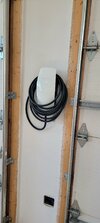Hey All,
I have had multiple electricians provide quotes to install a wall charger and one of them is saying that I need to upgrade the service to my house from 200A to 300 or 400A (which they can do). The rest of them did not bring this up as a concern with installing it.
The guy saying this is one from Tesla's electrician search list. I will be having another one from that list come in on Friday this week. I will update here what he says.
But wanted to post here to see if anyone else had this situation and any advise. The service to my house is 200A and I only have a electric dryer/washer and cooling HVAC. Rest of the appliances are gas. There are empty slots available in the exterior main breaker box. Thanks in advance for your responses.
I have had multiple electricians provide quotes to install a wall charger and one of them is saying that I need to upgrade the service to my house from 200A to 300 or 400A (which they can do). The rest of them did not bring this up as a concern with installing it.
The guy saying this is one from Tesla's electrician search list. I will be having another one from that list come in on Friday this week. I will update here what he says.
But wanted to post here to see if anyone else had this situation and any advise. The service to my house is 200A and I only have a electric dryer/washer and cooling HVAC. Rest of the appliances are gas. There are empty slots available in the exterior main breaker box. Thanks in advance for your responses.



